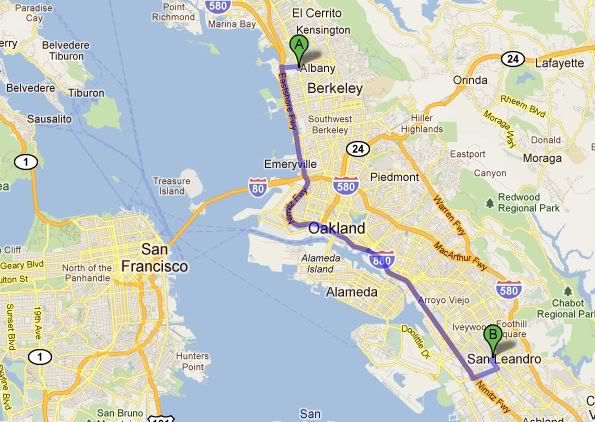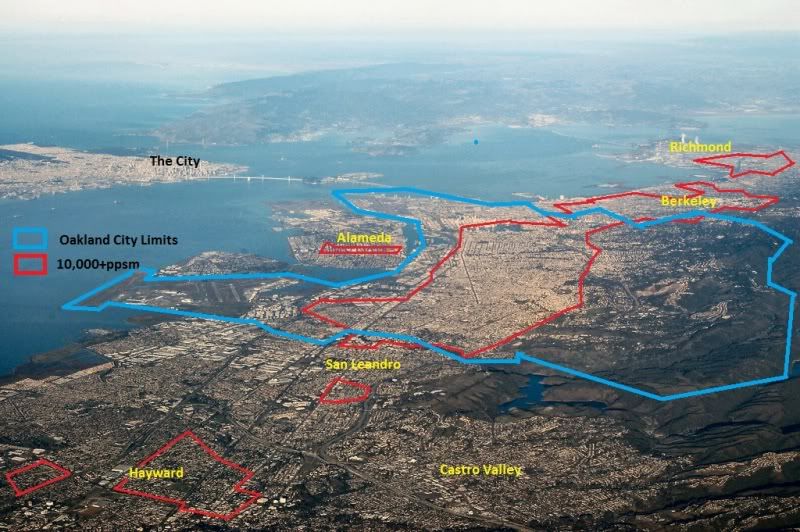Quote:
Originally Posted by HenryAlan

It would be interesting to see what happens if you exclude the bay itself from the SF map. What is the area size of 5,000 ppm occupied land on each map? Also, I'd wonder what happens when you go to, say 10,000 ppm.
|
For SF, using 10,000+ as the threshold, Oakland and the East Bay really comes into play.
According to City-Data, there is a huge swath of connected neighborhoods with an average density of10,000ppsm+ extending all the way into San Leandro(3 neighborhoods connected to Oakland) and Albany(1 neighborhood connected to Berkeley) as well as about 2 dozen other Oakland neighborhoods that are connected to the former list of areas.
the area of 10,000+persons per square mile Extends over an area that is 18 Miles North to South from Downtown Albany to Farrelly Pond, San Leandro. Along this route:

Here is the updated list of Oakland, Berkeley, San Leandro and Albany connected neighborhoods with a density of 10,000+ppsm
Neighborhood, City, Population Per Square Mile
Oak Tree Neighborhood, Oakland 34,447
Gold Coast Neighborhood, Oakland 29,212
Telegraph Ave neighborhood, Berkeley 28,188
Adams Point Neighborhood, Oakland 26,632
Clinton Neighborhood, Oakland 25,677
Ivy Hill Neighborhood, Oakland 22,866
St Elizabeth Neighborhood, Oakland 21,327
Merritt Neighborhood, Oakland 19,957
Harrington Neighborhood, Oakland 19,951
Patten Neighborhood, Oakland 19,950
Highland Terrace Neighborhood, Oakland 18,625
Allendale Neighborhood, Oakland 18,880
Seminary Neighborhood, Oakland 17,899
Tuxedo Neighborhood, Oakland 17,502
Rancho San Antonio Neighborhood, Oakland 17,290
School Neighborhood, Oakland, CA 16,916
Hawthorne Neighborhood, Oakland 16,752
Meadow Brook Neighborhood, Oakland 16,772
Grand Lake Neighborhood, Oakland 16,716
Bella Vista Neighborhood, Oakland 16,713
Chinatown Neighborhood, Oakland 16,554
Southside Neighborhood, Berkeley 16,438
Fremont Neighborhood, Oakland 16,096
Oakland Ave/Harrison St Neighborhood, Oakland 15,980
Cox Neighborhood, Oakland 15,674
Hegenberger Neighborhood, Oakland 15,406
Fairfax Business Neighborhood, Oakland 15,242
Sausal Creek Neighborhood, Oakland 15,138
Peralta Hacienda Neighborhood, Oakland 14,811
Jefferson Neighborhood, Oakland 14,807
Wentworth-Holland Neighborhood, Oakland 14,794
Elmwood Neighborhood, Berkeley 14,603
Webster Neighborhood, Oakland 14,294
College Avenue Neighborhood, Berkeley 14,125
Eastmont Neighborhood, Oakland 14,002
Upper Peralta Creek Neighborhood, Oakland 13,959
East Peralta Neighborhood, Oakland 13,948
Highland Park Neighborhood, Oakland 13,705
Gourmet Ghetto Neighborhood, Berkeley 13,494
Castlemont Neighborhood, Oakland 13,414
Arroyo Viejo Neighborhood, Oakland 13,404
Cleveland Heights Neighborhood, Oakland 13,354
Fairfax Neighborhood, Oakland 12,993
Civic Center Neighborhood, Oakland, 12,856
North Neighborhood, Berkeley 12,815
Old Oakland Neighborhood, Oakland 12,280
Gaskill Neighborhood, Oakland 12,276
Iveywood Neighborhood, Oakland 12,136
Paradise Park neighborhood, Oakland 11,886
Piedmont Avenue Neighborhood, Oakland 11,798
South Berkeley neighborhood, Berkeley 11,749
Havenscourt Neighborhood, Oakland 11,639
North Stonehurst Neighborhood, Oakland 11,625
Farelly Pond Neighborhood, San Leandro 11,315
Central Berkeley Neighborhood, Berkeley 11,280
Fairview Park Neighborhood, Oakland 11,213
San Pablo Gateway Neighborhood, Oakland 11,151
Santa Fe Neighborhood, Oakland 11,132
Upper Laurel Neighborhood, Oakland 11,117
Laurel Neighborhood, Oakland 10,973
Longfellow Neighborhood, Oakland 10,896
Downtown Neighborhood, Albany 10,888
Las Palmas Neighborhood, Oakland 10,838
Bushrod Neighborhood, Oakland 10,810
Eastshore Neighborhood, San Leandro 10,738
Lakeshore Neighborhood, Oakland 10,736
Upper Dimond Neighborhood, Oakland 10,626
Creekside Neighborhood, San Leandro 10,393
Also, there is another large cluster a few miles North of the Oakland-Berkeley cluster of 10,000+ppsm in
Richmond-San Pablo which includes the entire city of San Pablo and the entire Unincorporated town of Rollingwood
Richmond & San Pablo connected neighborhoods
Rollingwood CDP, 14,879 persons per square mile
Forest Park Neighborhood, Richmond 14,475 persons per square mile
City Center Neighborhood, Richmond 13,706 persons per square mile
Belding Woods Neighborhood, Richmond 13,273 persons per square mile
Eastshore Neighborhood, Richmond 11,710 persons per square mile
San Pablo City, 12,057 persons per square mile
Iron Triangle Neighborhood, Richmond 10,389 persons per square mile
Panhandle Annex Neighborhood, Richmond 10,299 persons per square mile
I made a map to satisfy my own curiosity.

This also shows how dense the Bay Area is outside the cities of SF and Oakland.
That large red area of 10,000+ppsm in Hayward is 27 miles from the City.

 Please register to participate in our discussions with 2 million other members - it's free and quick! Some forums can only be seen by registered members. After you create your account, you'll be able to customize options and access all our 15,000 new posts/day with fewer ads.
Please register to participate in our discussions with 2 million other members - it's free and quick! Some forums can only be seen by registered members. After you create your account, you'll be able to customize options and access all our 15,000 new posts/day with fewer ads.